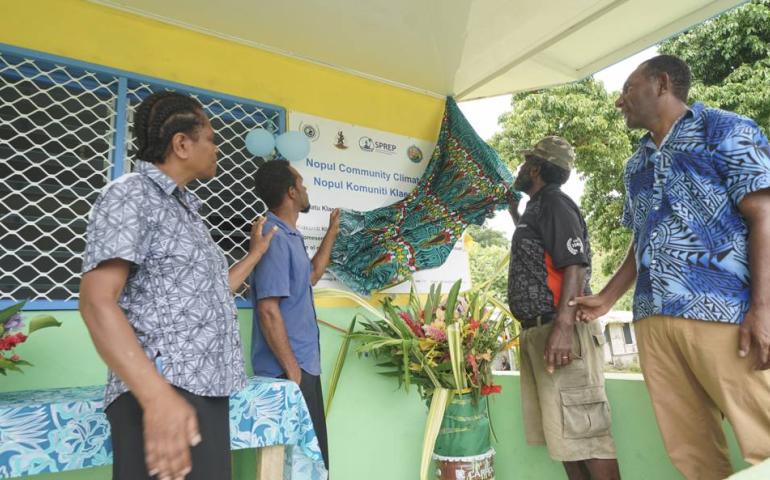FINPAC sets its mark in the region
By Ana Uili of MEIDAC
17 August, 2017, Honiara, Solomon Islands, PMC-4 – Since its inception in 2012, the FINPAC Project has made its mark in the Pacific by introducing many firsts to the region.
Two components of the project involve bridging gaps between the media and National Meteorological Hydrological Services (NMHSs) and engaging Pacific communities as users and recipients of weather and climate information.
Media
Secretariat of the Pacific Regional Environment Programme’s Climate and Meteorology Officer Mr. Salesa Nihmei said so far FINPAC has funded media trainings for more than 10 countries in the region.
“One of the big components of the project is to do media trainings in the countries. We don’t go out and teach the MET services on how to talk or how to write media articles, but we bring the media in and from there we developed for the MET services a plan on how to engage and this has gone really well.”
Mr Nihmei said through this project the media was brought in to the first Pacific Ministerial Meeting that was held in Tonga in 2015 and exposed journalists to the many different meteorological issues that were discussed.
Engaging Communities
Another major component of the project involves working with communities to strengthen their ability to use and apply meteorological data and to develop plans that can address both climate change and disasters, according to the senior meteorologist with SPREP.
“One of the biggest parts of the project is engaging communities so the process that we adopted through the FINPAC project were later refined when we started going in to other countries. We went in together with our partners to train MET services on how to engage with communities.”
“For some MET services it was the first time for them to engage with their communities and discuss their products and get feedbacks from the communities.”
Mr. Nihmei said the process used by the project to engage communities also allowed the MET services to go out and connect with their respective communities.
He stated that the Ministerial Meeting on Meteorology was also a delivery of the project but is now owned by the Pacific Meteorological Council.
FINPAC in Tonga
Director of Tonga’s Meteorological Service Mr. ‘Ofa Fa’anunu said that a lot of the assistance received from the project helped with building the capacity of the meteorology staff in Tonga.
“I think the FINPAC Project made a lot of impact in an area that we still have a lot of difficulties with in meteorological services and that is working with the communities.”
“With the FINPAC Project, it was the first time for the Tonga Meteorological Service to go out and work with a community and getting involved with the Red Cross and to produce useful dialogue with the community,” he explained.
Assistant CEO of Samoa’s Meteorology Office Mr. Mulipola Ausetalia Titimaea commended the achievements of the project and suggested that the meeting consider another project that can carry on the good work of FINPAC.
FINPAC is funded by the Government of Finland and is coordinated through SPREP and was implemented in 14 Pacific island countries. – #PMC4 #PacificMet
The Fourth Pacific Meteorological Council is being held in Honiara, Solomon Islands from the 14 – 17 August co-hosted by the government of Solomon Islands, the Secretariat of the Pacific Regional Environment Programme (SPREP) and World Meteorological Organization (WMO). This will followed by the Second Pacific Meteorological Ministers Meeting (PMMM) on the 18 of August.
The PMC and PMMM is supported by the Government of Solomon Islands, SPREP, WMO, Government of Australia through the Climate and Oceans Support Programme (COSPPac) and Pacific Australia Climate Change Science and Adaptation Planning Programme (PACCSAP), Government of Finland, National Ocean and Atmospheric Administration (NOAA), United Nations Development Programme through the Resilience in the Pacific (SIDS) project.
The PMC consists of members of the Pacific National Meteorological and Hydrological Services supported by its technical partners, regional organisations, non-government organisations and private sectors.
This article was developed by a Pacific Media Team of Reporters currently providing coverage on the Fourth Pacific Meteorological Council in Solomon Islands. This activity coordinated by SPREP is supported by a partnership between the Government of Solomon Islands, SPREP, Australia funded project (Climate and Oceans Support Program (COSPPac) and UNDP Disaster for Pacific SIDS (RESPAC) project.
The views and opinions expressed in this article are those of the writer and do not necessarily reflect the views of the Secretariat of the Pacific Regional Environment Programme (SPREP) or the United Nations Development Programme (UNDP)both of which provided funding for generating media articles
- Log in to post comments




